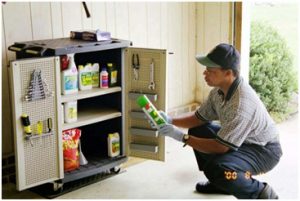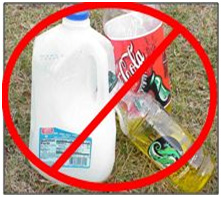Follow these guidelines to store pesticides safely:
 Follow all storage instructions on the pesticide label.
Follow all storage instructions on the pesticide label.- Do not stockpile. Reduce storage needs by buying only the amount of pesticide that you will need during the current season when the pest is active.
- Never store pesticides in application equipment. Only mix the amount needed for the current application. If the application is complete, but excess mixture remains in the equipment, continue to apply according to the label directions.
- Store pesticides out of reach of children and pets.
- Keep all pesticides in a locked cabinet in a well-ventilated utility area or garden shed.
- Never store pesticides under kitchen or bathroom sinks.
- Use child-resistant packaging correctly – close the container tightly after using the product. Child resistant does not mean child proof, so you still must be extra careful to store properly – out of children’s reach.
- Store pesticides in a cool, dry, well-ventilated area, protected from freezing temperatures and away from heat sources and direct sunlight.
- Store flammable liquids outside your living area and far away from an ignition source such as a furnace, a car, an outdoor grill, or a power lawn mower.
- Never store pesticides in cabinets with or near food, animal feed, or medical supplies.
- Do not store pesticides in places where flooding is possible or in places where they might spill or leak into wells, drains, groundwater, or surface water.
 Always store pesticides in their original containers, complete with its label. Never transfer pesticides to soft drink bottles or other containers. Children or others may mistake them for something to eat or drink.
Always store pesticides in their original containers, complete with its label. Never transfer pesticides to soft drink bottles or other containers. Children or others may mistake them for something to eat or drink.- Preserve the product label in a legible condition; consider making an extra copy for safekeeping. Do not allow the label to become missing, damaged, or destroyed.
- Inspect containers periodically for damage or leaks.
- If you can’t identify the contents of the container, or if you can’t tell how old the contents are, follow the advice on safe disposal in the next section.
Compiled by Wayne Buhler, PhD.
